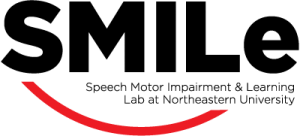Publications
Stay tuned on our latest publications!Allison, K.M., Millington, M. & Grimm, A. (2025). Can We Trust Our Ears: How Accurate and Reliable are SLPs’ Estimates of Children’s Speech Intelligibility? American Journal of Speech-Language Pathology. epub ahead of print. https://doi.org/10.1044/2024_AJSLP-24-00247
Sullivan, L., Martin, E. & Allison, K.M. (2024). Effects of SPEAK OUT! & LOUD Crowd on Functional Speech Measures in Parkinson’s Disease. American Journal of Speech-Language Pathology, 33(4), 1930-1951. DOI: https://doi.org/10.1044/2024_AJSLP-23-00321
Allison, K.M. & Doherty, K. (2024). Relations of speech-language profile and communication modality to participation of children with cerebral palsy. American Journal of Speech-Language Pathology. 33(2), 1040-1050. DOI: 10.1044/2023_AJSLP-23-00267
Alsebayel, G., Nasri, M., Myers, C., Troiano, G., Hatamimajoumerd, E., Ostadabbas, S., Allison, K.M. & Harteveld, C. (2024). ArticuMotion: Towards Assessing Motor Speech Disorders via Gamification. In Proceedings of the 2024 IDC Conference on Interaction Design and Children (IDC ’24), June 17–20, 2024, Delft, Netherlands. ACM, New York, NY, USA, 16 pages. https://doi.org/10.1145/3628516.3655815
Young, S.D., McGrattan, K., Johnson, E., van der Heul, M., Duong, T., Bakke, M., Werlauff, U., Pasternak, A., Cattaneo, C., Hoffman, K., Fanelli, L., Breaks, A., Allison, K.M., Baranello, G., Finkel, R., Coratti, G., Lofra, R. (2023). Development of an International SMA Bulbar Assessment for Inter-professional Administration. Journal of Neuromuscular Diseases, 10(4), 639-652. DOI: 10.3233/JND-221672
Allison, K.M., Iuzzini-Seigel, J., & Stoeckel, R. (2023). Motor Speech Phenotypes in Children with Epilepsy: Preliminary Findings. American Journal of Speech-Language Pathology, 32(4S), 1912-1922. DOI: 10.1044/2022_AJSLP-22-00176
Iuzzini-Seigel, Jenya & Allison, Kristen & Stoeckel, Ruth. (2022). A Tool for Differential Diagnosis of Childhood Apraxia of Speech and Dysarthria in Children: A Tutorial. Language, Speech, and Hearing Services in Schools. 53. 1-21. 10.1044/2022_LSHSS-21-00164.
Allison, K. M., & Levac, D. E. (2022). Impact of the COVID-19 pandemic on therapy service delivery and functioning for school-aged children with disabilities in the United States. Disability and health journal,15(2), 101266. https://doi.org/10.1016/j.dhjo.2021.101266
Allison, K. M., Nip, I. S. B., & Rong, P. (2022). Use of Automated Kinematic Diadochokinesis Analysis to Identify Potential Indicators of Speech Motor Involvement in Children With Cerebral Palsy. American journal of speech-language pathology, 31(6), 2835–2846. https://doi.org/10.1044/2022_AJSLP-21-00241
Allison, K. M., Russell, M., & Hustad, K. C. (2021). Reliability of Perceptual Judgments of Phonetic Accuracy and Hypernasality Among Speech-Language Pathologists for Children With Dysarthria. American journal of speech-language pathology,30(3S), 1558–1571. https://doi.org/10.1044/2020_AJSLP-20-00144
Rong, P., Usler, E., Rowe, L. M., Allison, K., Woo, J., El Fakhri, G., & Green, J. R. (2021). Speech intelligibility loss due to amyotrophic lateral sclerosis: the effect of tongue movement reduction on vowel and consonant acoustic features. Clinical linguistics & phonetics, 35(11), 1091–1112. https://doi.org/10.1080/02699206.2020.1868021
Allison, K.M., Cordella, C., & Iuzzini-Seigel, J. (2020). Differential diagnosis of apraxia of speech in children and adults: A scoping review. Journal of Speech, Language, and Hearing Research, 63(9), 2952-2994. doi: 10.1044/2020_JSLHR-20-00061 https://pubs.asha.org/doi/10.1044/2020_JSLHR-20-00061?url_ver=Z39.88-2003&rfr_id=ori:rid:crossref.org&rfr_dat=cr_pub%20%200pubmed
Allison, K. M., Salehi, S., & Green, J. R. (2020). Effect of prosodic manipulation on articulatory kinematics and second formant trajectories in children. The Journal of the Acoustical Society of America, 147(2), 769–776. doi: 10.1121/10.0000670 https://asa.scitation.org/doi/10.1121/10.0000670
Allison, K.M. (2020). Measuring speech intelligibility in children with motor speech disorders. SIG 2 Neurogenic Communication Disorders, 5(4), 809-820. doi: 10.1044/2020_PERSP-19-00110 https://pubs.asha.org/doi/10.1044/2020_PERSP-19-00110
Allison, K.M., Yunusova, Y. & Green, J.R. (2019). Shorter sentence length maximizes intelligibility and speech motor performance in persons with dysarthria due to ALS. American Journal of Speech-Language Pathology, epub ahead of print. https://pubs.asha.org/doi/10.1044/2018_AJSLP-18-0049?url_ver=Z39.88-2003&rfr_id=ori:rid:crossref.org&rfr_dat=cr_pub%20%200pubmed
Allison, K.M., Yunusova, Y. & Green, J.R. (2019). Shorter sentence length maximizes intelligibility and speech motor performance in persons with dysarthria due to ALS. American Journal of Speech-Language Pathology, epub ahead of print. https://pubs.asha.org/doi/10.1044/2018_AJSLP-18-0049?url_ver=Z39.88-2003&rfr_id=ori:rid:crossref.org&rfr_dat=cr_pub%20%200pubmed
Allison, K. M., & Hustad, K. C. (2018). Data-Driven Classification of Dysarthria Profiles in Children with Cerebral Palsy. Journal of Speech, Language, and Hearing Research, 61(12), 2837-2853. https://pubs.asha.org/doi/10.1044/2018_AJSLP-18-0049?url_ver=Z39.88-2003&rfr_id=ori:rid:crossref.org&rfr_dat=cr_pub%20%200pubmed
Allison, K.M. & Hustad, K.C. (2018). Acoustic predictors of pediatric dysarthria in cerebral palsy. Journal of Speech, Language, and Hearing Research, 1-17. Green, J.R., Allison, K.M., Cordella, C., Richburg, B.D., Pattee, G.L., Berry, J.D., Macklin, E.A., Pioro, E.P., & Smith, R.A. (2018). Additional evidence for a therapeutic effect of dextromethorphan/quinidine on bulbar motor function in persons with ALS: A quantitative speech analysis. British Journal of Clinical Pharmacology. 84(12), 2849-2856. https://pubs.asha.org/doi/10.1044/2018_AJSLP-18-0049?url_ver=Z39.88-2003&rfr_id=ori:rid:crossref.org&rfr_dat=cr_pub%20%200pubmed
[before SMILe Lab (est. 2018)]
Allison, K.M., Yunusova, Y., Campbell, T., Wang, J., Berry, J. & Green, J.R. (2017). The diagnostic utility of patient-report and speech-language pathologists’ ratings for detecting the early onset of bulbar symptoms due to ALS. Amyotrophic Lateral Sclerosis and Frontotemporal Degeneration, 18(5-6), 358-366. https://www.tandfonline.com/doi/abs/10.1080/21678421.2017.1303515?journalCode=iafd20&
Allison, K. M., Annear, L., Policicchio, M., & Hustad, K. C. (2017). Range and Precision of Formant Movement in Pediatric Dysarthria. Journal of Speech, Language, and Hearing Research, 60(7), 1864-1876. https://pubs.asha.org/doi/10.1044/2017_JSLHR-S-15-0438?url_ver=Z39.88-2003&rfr_id=ori:rid:crossref.org&rfr_dat=cr_pub%20%200pubmed
Hustad, K.C., Allison, K.M., Sakash, A., McFadd, E., Broman, A.T., Rathouz, P.J. (2016). Longitudinal development of communication in children with cerebral palsy between 24 and 53 months: Predicting speech outcomes. Developmental Neurorehabilitation, 20(6), 323-330. https://www.ncbi.nlm.nih.gov/pmc/articles/PMC5409890/
Hustad, K.C., Oakes, A., McFadd, E., & Allison, K.M. (2015) Alignment of classification paradigms for communication in children with cerebral palsy. Developmental Medicine and Child Neurology. 58(6), 597-604. https://onlinelibrary.wiley.com/doi/full/10.1111/dmcn.12944
Hustad, K.C., Oakes, A., & Allison, K.M. (2015). Variability, stability, and diagnostic accuracy of speech intelligibility scores in children. Journal of Speech Language and Hearing Research, 58(6), 1695-1707. https://pubs.asha.org/doi/10.1044/2015_JSLHR-S-14-0365?url_ver=Z39.88-2003&rfr_id=ori:rid:crossref.org&rfr_dat=cr_pub%20%200pubmed
Allison, K.M. & Hustad, K.C. (2014). Impact of sentence length and phonetic complexity on intelligibility of 5-year-old children with cerebral palsy. International Journal of Speech-Language Pathology, 16(4), 396-407. https://pubs.asha.org/doi/10.1044/2015_JSLHR-S-14-0365?url_ver=Z39.88-2003&rfr_id=ori:rid:crossref.org&rfr_dat=cr_pub%20%200pubmed
Hustad, K.C., Allison, K.M., McFadd, E., & Riehle, K. (2013). Speech and Language Development in 2 Year Old Children with Cerebral Palsy. Developmental Neurorehabilitation, 17(3), 167-175. https://www.tandfonline.com/doi/abs/10.3109/17518423.2012.747009?journalCode=ipdr20
Allison, K.M. & Turkstra, L. (2012). Navigating medical speech-language pathology reports for children with TBI. Perspectives on School-Based Issues, 13(3), 63-69. https://pubs.asha.org/doi/10.1044/sbi13.3.63
(2012) Outcomes of a Clinic-Based Pediatric Constraint-Induced Movement Therapy Program, Physical & Occupational Therapy In Pediatrics, 32:4, 355-367, DOI: 10.3109/01942638.2012.694991
